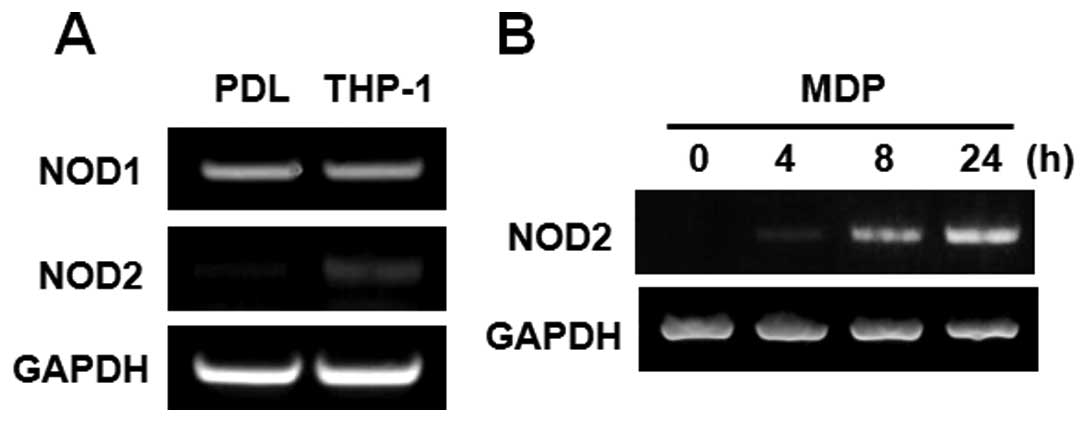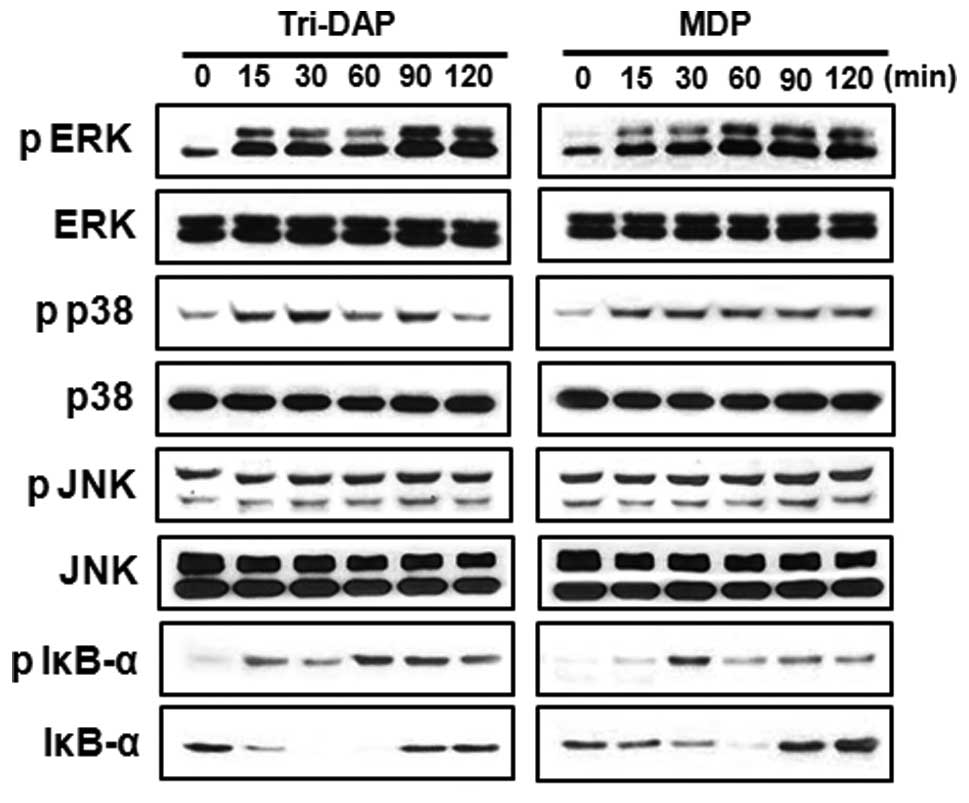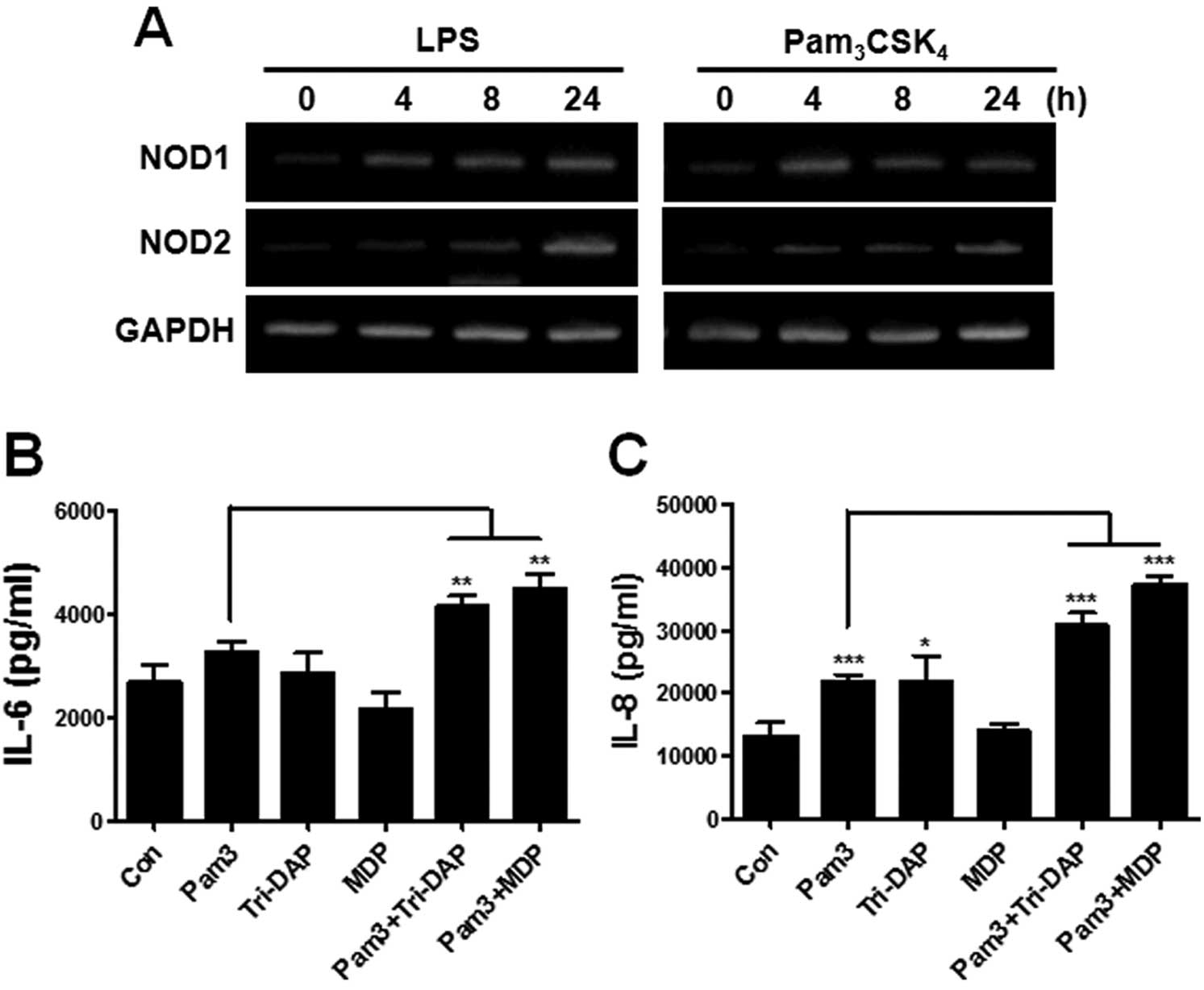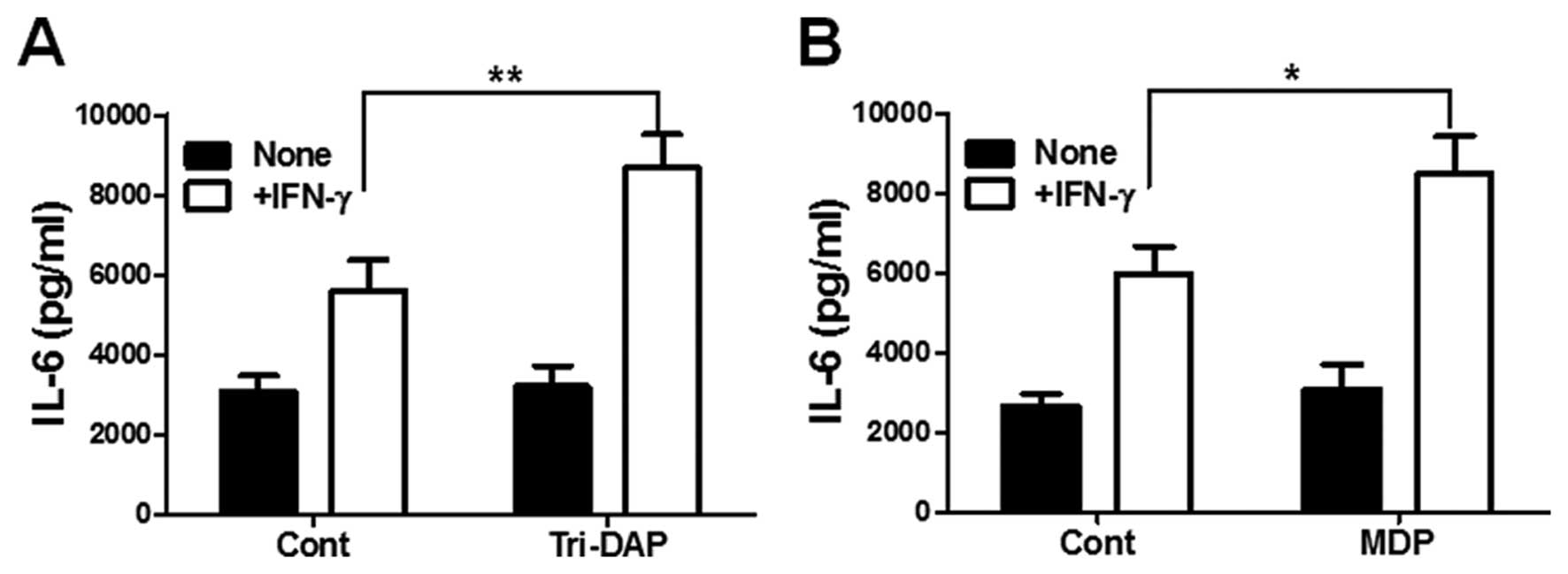NOD1 and NOD2 stimulation triggers innate immune responses of human periodontal ligament cells
- Authors:
- Published online on: January 3, 2012 https://doi.org/10.3892/ijmm.2012.878
- Pages: 699-703
Abstract
Introduction
Host defense is achieved by two different immune systems, innate and adaptive immunity. Innate immunity is the first line of defense process to protect the host from microbial pathogens and is primarily mediated by phagocytes such as macrophages and dendritic cells (1–4). The innate immunity recognizes microorganisms via a limited number of pattern-recognition receptors (PRRs), which recognize microbial components, known as pathogen-associated molecular patterns (PAMPs). Toll-like receptors (TLRs) and Nod-like receptors (NLRs) are the representative PRRs.
They recognize microbial molecules including bacterial lipoprotein, lipopolysaccharide (LPS), flagellin, and viral nucleic acids, at the cell surface or endosomal membrane and subsequently activate NF-κB and MAPK to trigger the inflammatory process (1). In addition to microbial molecules, a variety of endogenous ligands, such as heat shock proteins, high mobility group box 1 (HMGB1), hyaluronan fragments, heparin sulphate, and fibronectin are recognized by TLR2 or TLR4 (5). In contrast, NLRs are intracellular, cytoplasmic sensors for microbial components and danger signals (6,7). There are 23 NLR family members in humans and at least 34 NLR genes in mice (7). NLRs are expressed in non-immune cells including epithelial and mesothelial cells as well as immune cells. Nucleotide-binding oligomerization domain (NOD)1 and NOD2, the first identified NLRs consist of an N-terminal caspase recruitment domain (CARD), an intermediate NOD, and a C-terminal leucine-rich repeats (LRRs) domain (8). NOD1 and NOD2 recognize the peptidoglycan derivatives, meso-diaminopimelic acid (meso-DAP) and muramyl dipeptide (MDP), respectively (8). After stimulation by their specific bacterial molecules, NOD1 and NOD2 associate with the adaptor molecule, RICK/Rip2/CARDIAK, through CARD-CARD interaction, which leads to activation of NF-κB and MAPK, followed by induction of numerous genes involved in the inflammatory process (9–11).
Periodontitis is a chronic inflammatory disease initiated on the periodontium by toxin and oxygen produced from periodontopathic bacteria (12), which results in tooth loss and periodontal bone resorption because the supportive tissue surrounding the teeth was destructed. Gram-negative bacteria such as Porphyromonas gingivalis, Aggregatibacter actinomycetemcomitans and Fusobacterium necleatum have been considered to be important pathogenic microorganisms associated with periodontitis (12–14).
Periodontal ligament (PDL) cells not only function as supporting cells for periodontal tissues but also produce inflammatory mediators that recognize various molecules including LPS (15). There is evidence that TLRs mediate immune responses of PDL cells against periodontal infections (16,17). However, little is known about the role of NOD1 and NOD2 in innate immune responses of PDL cells. Therefore, in the present study, we examined the function of NOD1 and NOD2 in the innate immune responses of human PDL cells.
Materials and methods
Cell culture and reagents
A human periodontal ligament cell line was a gift from Dr Maeda (Kyushu University Hospital, Fukuoka, Japan). This cell line was immortalized by SV40 T-antigen and hTERT gene transfer (18). THP-1 cells, a human monocytic leukemia cell line, were used as a positive control. PDL cells were cultured in Minimum Essential Medium α (Gibco, Grand Island, NY, USA) containing 1X penicillin/streptomycin and 10% fetal bovine serum in 5% CO2 incubator at 37°C. Tri-DAP, Pam3CSK4, LPS, and recombinant human IFN-γ were purchased from Invivogen, Inc. (San Diego, CA, USA) and muramyl dipeptide [MDP; Ac-(6-O-strearoyl)-muramyl-Ala-D-Glu-NH2] was from Bachem, Inc. (Torrance, CA, USA).
RT-PCR
Total-RNA was extracted from the cell using easy-BLUE (Intron Biotechnology, Daejeon, Korea) according to the manufacturer’s instruction. One microgram of total-RNA was reverse transcribed into cDNA, and PCR was performed using the Power cDNA Synthesis kit (Intron Biotechnology) and One-step RT-PCR with AccuPower® HotStart PCR PreMix (Bioneer, Daejeon, Korea). The following primer sets were used. Human NOD1, forward, 5′-CCACTTCACAGCTGGAG ACA-3′ and reverse, 3′-TGAGTGGAAGCAGCATTTTG-5′; human NOD2, forward, 5′-GAATGTTGGGCACCTCAAGT-3′ and reverse, 3′-CAAGGAGCTTAGCCATGGAG-5′; human GAPDH, forward, 5′-GTCGGAGRCAACGGATT-3′ and reverse, 3′-AAGCTTCCCGTTCTCAG-3′.
The PCR reaction condition included pre-denaturing at 94°C for 30 sec, then 35–40 cycle of 56°C for 30 sec, 72°C for 1 min. PCR products were then electrophoresed on a 1.5% agarose gel and visualized using a gel documentation system.
Measurement of IL-6 and IL-8
The cells in triplicate were treated with the indicated doses of Tri-DAP and MDP or combination with TLR agonist or IFN-γ for 24 h and the culture supernatant was collected. The concentration of IL-6 and IL-8 in the culture supernatants were determined using a commercial ELISA kit (R&D Systems, Minneapolis, MN, USA)
Western blotting
The cells (1×106/well) were plated in 35-mm culture dishes. The cells were treated with 10 μg/ml of Tri-DAP and MDP and were lysed in buffer containing 1% Nonidet-P40 supplemented with a complete protease inhibitor cocktail (Roche) and 2 mM dithiothreitol. Lysates were resolved by 10% SDS-PAGE, transferred to a polyvinylidene fluoride (PVDF) membrane, and immunoblotted with primary antibodies against regular- and phospho-IκB-α, p38, ERK and JNK (Cell Signaling Technology, Inc., Beverly, MA, USA). After immunoblotting with secondary antibodies, proteins were detected with an enhanced chemiluminescence (ECL) reagent (Intron Biotechnology).
Statistical analysis
The differences among the mean values of the different groups were assessed, and the values are expressed as the mean ± SD. All of the statistical calculations were performed by one-way ANOVA using the GraphPad Prism version 5.01 (GraphPad Software, San Diego, CA, USA). Values of P<0.05 were considered significant.
Results
Expression of NOD1 and NOD2 in PDL cells
The gene expression of NOD1 and NOD2 in PDL cells were examined by RT-PCR. THP-1 cells, human monocyte leukemia cells, were used as a positive control. The gene of NOD1 was strongly expressed in PDL cells, and NOD1 levels were comparable to that in THP-1 cells. In contrast, NOD2 expression was found to be low level in PDL cells, as compared to THP-1 cells (Fig. 1A). However, the stimulation with MDP, a specific NOD2 agonist, augmented the gene expression of NOD2 in a time-dependent manner in PDL cells (Fig. 1B).
NOD1 and NOD2 stimulation leads to increased production of IL-6 and IL-8 in PDL cells
To determine whether the stimulation of NOD1 and NOD2 leads to the production of pro-inflammatory cytokines/chemokines, the cells were treated with Tri-DAP (NOD1 agonist) and MDP (NOD2 agonist) and the production of IL-6 and IL-8 from culture supernatants was determined by ELISA. Both Tri-DAP and MDP can lead to increased production of IL-6 and IL-8 production in PDL cells in a dose-dependent manner (Fig. 2). Both IL-6 and IL-8 production was more increased by Tri-DAP than MDP, suggesting that NOD1 may play a more important role in the immune response of PDL cells than NOD2.
Tri-DAP and MDP induce NF-κB and MAPK activation in PDL cells
Sensing of microbial molecules by NOD1 and NOD2 induce the activation of NF-κB and MAPK in various cell types including macrophages (19–21). To determine whether NOD1 and NOD2 stimulation leads to NF-κB and MAPK activation in PDL cells, the cells were treated with Tri-DAP or MDP and extracts were prepared at different times after stimulation. Subsequently, immunoblotting was performed using antibodies that recognize activated forms of IκB-α, p38, JNK and ERK. Results showed that both Tri-DAP and MDP induced phosphorylation of IκB-α, p38 and ERK, but not JNK (Fig. 3). The kinetics of IκB-α phosphorylation and degradation were different between Tri-DAP and MDP. Fifteen minutes after stimulation, Tri-DAP induced phosphorylation of IκB-α and maximal phosphorylation was detected at 60 and 90 min after stimulation. However, MDP induced optimal phosphorylation of I-κBα at 30 min after stimulation, which was reduced after that time (Fig. 3).
TLR stimulation enhances the gene expression of NOD1 and NOD2 and augments the production of IL-6 and IL-8 increased by Tri-DAP and MDP in PDL cells
It has been known that TLRs synergize with NOD1 and NOD2 to produce cytokines in macrophages and dendritic cells (20,22). We first examined whether stimulation by TLRs affects the gene expression of NOD1 and NOD2 in PDL cells. The treatment of LPS (a TLR4 agonist) and Pam3CSK4 (a TLR2 agonist) could enhance the gene expression of NOD1 and NOD2 beginning at 4 h after stimulation (Fig. 4A). We next investigated whether activation of TLRs can augment the ability of PDL cells to produce IL-6 and IL-8 by Tri-DAP and MDP. Dose response experiments were performed to determine an appropriate dose of Pam3CSK4 to induce marginal production of IL-6 and IL-8. Results revealed that 0.1 μg/ml of Pam3CSK4 led to a minor increase of IL-6 and IL-8 production in PDL cells (data not shown), and this concentration was used for further experiments. For the synergism experiment, the cells were treated with indicated agonists alone or their combination for 24 h and IL-6 and IL-8 production was measured from culture supernatants. As shown in Fig. 4, combination treatment of Pam3CSK4 and Tri-DAP or MDP significantly augmented IL-6 or IL-8 production in PDL cells, as compared to the single agonist-treated group (Fig. 4B and C).
IFN-γ synergizes with Tri-DAP and MDP to produce IL-6 in PDL cells
Finally, we examined whether IFN-γ can augment Tri-DAP and MDP-induced cytokine production by PDL cells. IFN-γ alone could increase IL-6 production in PDL cells (Fig. 5A). In addition, co-stimulaion with Tri-DAP upregulated IL-6 production in PDL cells, as compared to IFN-γ or Tri-DAP alone (Fig. 5A). Furthermore, combination treatment with MDP and IFN-γ also enhanced IL-6 production by PDL cells, although a low dose of MDP alone (0.1 μg/ml) could not increase IL-6 production (Fig. 5B).
Discussion
Recent studies have demonstrated that NOD1 and NOD2 are expressed in various cell types that exist within the oral tissues and play a role in triggering immune responses (23–25). In healthy gingival tissues, NOD1 and NOD2 exhibit stronger expression than TLRs (24). NOD1 and NOD2 are also expressed in various oral epithelial cells and the stimulation with iE-DAP and MDP upregulates the gene expression of β-defensin 2 (24). In human gingival fibroblasts, both NOD1 and NOD2 were strongly expressed and their agonists (FK156 for NOD1, MDP for NOD2) could increase the production of IL-6, IL-8 and MCP-1 via an NF-κB-dependent pathway (25). In addition, Hirao et al (23) showed the gene and protein expression of NOD1 and NOD2 in pulp fibroblasts and that iE-DAP and MDP could produce IL-8, suggesting that NOD1 and NOD2 are functionally expressed in pulp fibroblasts. Tang et al (26) showed the gene and protein expression and localization of NOD1 and NOD2 in human PDL fibroblasts. The activation of NOD1 and NOD2 led to the upregulation of tumor necrosis factor receptor-associated factor 6 (TRAF6) and pro-inflammatory cytokines in human PDL cells (26).
In the present study, we revealed that NOD1 is strongly expressed in PDL cells and the expression level is comparable to that in THP-1 cells. NOD2 expression was relatively weak in PDL cells. The expression level of NOD2 varies between cell types. The mRNA and protein of NOD2 was markedly expressed in hepatocytes, oral epithelial cells, and renal tubular epithelial cells (27–29), but was not expressed or was weakly expressed in intestinal epithelial cells (30). In addition, NOD2 expression seems to be regulated by specific treatment. Bacterial flagellin (a TLR5 agonist), E. coli, and IL-1β increased the gene expression of NOD2 in intestinal epithelial cells (30). Furthermore, in the presence of histamine, MALP-2 (a TLR2 agonist), peptidoglycan, and β-glucan also enhanced NOD2 gene expression in keratinocytes (31). In this study, the gene expression of NOD2 was upregulated by MDP stimulation, suggesting that NOD2 may be inducible in PDL cells. In addition, the activation of NOD1 and NOD2 with Tri-DAP and MDP led to IL-6 and IL-8 production and the activation of NF-κB and MAPK in PDL cells, indicating that NOD1 and NOD2 may be functionally expressed in PDL cells.
Previous studies showed that NOD1 and NOD2 have the synergistic or additive effect with TLRs to produce cytokines and chemokines in immune cells and mesothelial cells (20,21,32). These phenomena were also found in several epithelial cells. In oral epithelial cells, NOD1 and NOD2 agonists in combination with TLR agonists synergistically enhanced β-defensin 2 secretion (33). Moreover, LPS pretreatment enhanced the activation of NF-κB, ERK and JNK by MDP in hepatocytes (27). Likewise, in this study, NOD1 and NOD2 agonists (Tri-DAP and MDP) synergized with a TLR2 agonist Pam3CSK4 to produce IL-6 and IL-8 in PDL cells. Our results indicate that NOD1 and NOD2 may cooperate with TLRs to elicit immune responses in PDL cells.
IFN-γ is known to increase the expression of NOD1 and NOD2 in macrophages (34,35). In addition, IFN-γ is essential for a NOD1 agonist, KF1B-induced nitric oxide production in mesothelial cells (21). Therefore, we examined whether IFN-γ augments IL-6 production by NOD1 and NOD2 activation in PDL cells. Results showed that the co-stimulation with IFN-γ and Tri-DAP or MDP upregulated IL-6 production in PDL cells, as compared to IFN-γ or the agonist alone-treated group. These findings suggest that IFN-γ may enhance the innate immune response mediated by NOD1 and NOD2 signaling in PDL cells.
In conclusion, we reported here that NOD1 and NOD2 are functionally expressed in human PDL cells and the activation of these receptors can induce innate immune responses such as cytokine production and the activation of NF-κB and MAPK. In addition, our results revealed that TLRs can synergize with NOD1 and NOD2 to produce proinflammatory cytokines/chemokines. Similarly to immune responses, NOD1 and NOD2 signaling can mediate cellular physiological functions, such as proliferation and differentiation (36–38). Future studies should clarify the function of NOD1 and NOD2 on the cellular physiology of PDL cells.
Acknowledgements
This study was supported by a grant by the Korea Science and Engineering Foundation (KOSEF) funded by the Korean government (MOST) (grant no. R13-2008-010-00000-0).














